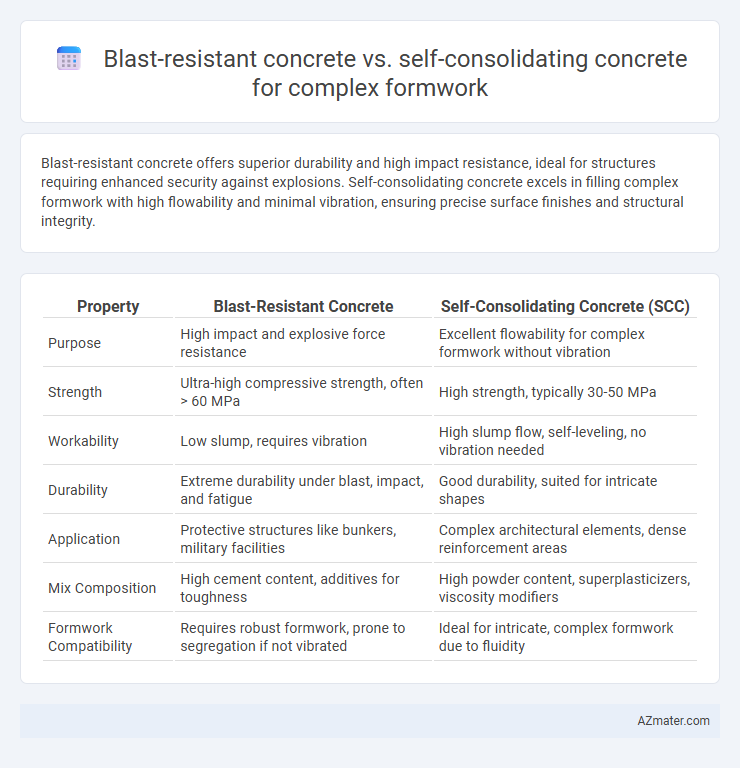Blast-resistant concrete offers superior durability and high impact resistance, ideal for structures requiring enhanced security against explosions. Self-consolidating concrete excels in filling complex formwork with high flowability and minimal vibration, ensuring precise surface finishes and structural integrity.
Table of Comparison
| Property | Blast-Resistant Concrete | Self-Consolidating Concrete (SCC) |
|---|---|---|
| Purpose | High impact and explosive force resistance | Excellent flowability for complex formwork without vibration |
| Strength | Ultra-high compressive strength, often > 60 MPa | High strength, typically 30-50 MPa |
| Workability | Low slump, requires vibration | High slump flow, self-leveling, no vibration needed |
| Durability | Extreme durability under blast, impact, and fatigue | Good durability, suited for intricate shapes |
| Application | Protective structures like bunkers, military facilities | Complex architectural elements, dense reinforcement areas |
| Mix Composition | High cement content, additives for toughness | High powder content, superplasticizers, viscosity modifiers |
| Formwork Compatibility | Requires robust formwork, prone to segregation if not vibrated | Ideal for intricate, complex formwork due to fluidity |
Introduction to Specialized Concrete Types
Blast-resistant concrete is engineered with enhanced toughness and energy absorption to protect structures from explosive forces, making it vital for high-security or critical infrastructure. Self-consolidating concrete (SCC) exhibits exceptional flowability and segregation resistance, enabling it to fill intricate and densely reinforced formwork without mechanical vibration. Both specialized concretes are designed for specific structural challenges, with blast-resistant concrete prioritizing durability under extreme loading and SCC optimizing constructability in complex formwork scenarios.
Understanding Blast-resistant Concrete
Blast-resistant concrete incorporates high-strength aggregates and fiber reinforcements to enhance impact absorption and structural integrity under explosive loads. Its dense composition and specialized mix design improve energy dissipation, making it ideal for protective barriers and critical infrastructure. Understanding the material's compressive strength and ductility parameters is crucial for optimizing complex formwork applications where safety and durability are paramount.
Key Properties of Self-consolidating Concrete
Self-consolidating concrete (SCC) exhibits exceptional flowability and high stability, enabling it to fill complex formwork without mechanical vibration while maintaining uniform density and minimizing segregation. Its unique rheological properties, including low yield stress and high passing ability, ensure easy placement in intricate molds with tight reinforcement. In contrast to blast-resistant concrete, SCC prioritizes workability and surface finish, making it ideal for complex geometries requiring detailed formwork and reduced labor efforts.
Performance Requirements in Complex Formwork
Blast-resistant concrete offers superior durability and energy absorption crucial for structures exposed to explosive forces, ensuring enhanced safety in complex formwork applications. Self-consolidating concrete excels in fluidity and flowability, allowing it to fill intricate molds without vibration, reducing labor and improving surface finish in complex geometries. Performance requirements for complex formwork prioritize blast resistance for structural integrity under extreme loads, while self-consolidating concrete enhances formwork efficiency and aesthetic precision.
Durability and Strength Comparison
Blast-resistant concrete offers superior impact durability and high compressive strength, designed to withstand extreme loading conditions such as explosions, making it ideal for critical infrastructure requiring enhanced protective performance. Self-consolidating concrete provides excellent flowability and homogeneity for complex formwork, ensuring uniform strength distribution and reduced honeycombing but may not match the explosive impact resistance of blast-resistant mixes. In terms of long-term durability, blast-resistant concrete incorporates specialized aggregates and admixtures improving resistance to cracking and spalling, while self-consolidating concrete achieves durability through optimized particle packing and reduced voids, beneficial for intricate structural elements.
Workability and Placement Efficiency
Blast-resistant concrete offers high density and strength, enhancing structural durability but often exhibits lower workability, requiring specialized placement techniques for complex formwork. Self-consolidating concrete (SCC) ensures superior flowability and self-leveling properties, significantly improving placement efficiency in intricate molds without the need for vibration. Optimizing workability in SCC drastically reduces labor and time, whereas blast-resistant concrete prioritizes protective performance with more controlled placement processes.
Reinforcement Compatibility and Integration
Blast-resistant concrete requires careful reinforcement compatibility to absorb and dissipate explosive forces through closely spaced, high-strength steel bars integrated with fiber-reinforced polymers for enhanced energy absorption. Self-consolidating concrete excels in complex formwork due to its high flowability, allowing seamless integration with dense reinforcement grids without honeycombing or segregation, ensuring full encapsulation of steel rebar. The selection of concrete type heavily influences reinforcement layout and integration, with blast-resistant mixes demanding rigorous bond strength and self-consolidating concrete prioritizing fluidity for uniform coverage around intricate reinforcement configurations.
Cost Implications and Resource Efficiency
Blast-resistant concrete demands high-strength materials and specialized additives, significantly increasing initial costs compared to self-consolidating concrete, which requires optimized mix designs for superior flowability and reduced labor. Self-consolidating concrete offers enhanced resource efficiency by minimizing the need for vibration and ensuring uniform placement in complex formwork, leading to faster construction cycles and lower labor expenses. Cost implications favor self-consolidating concrete in complex formwork applications due to its reduced manpower requirements and decreased risk of defects, while blast-resistant concrete incurs higher expenses driven by stringent performance criteria and material specifications.
Industry Applications and Best Use Cases
Blast-resistant concrete offers superior durability and impact resistance, making it ideal for military installations, critical infrastructure, and protective barriers where explosive threats are a concern. Self-consolidating concrete excels in applications involving complex formwork due to its high flowability and ability to fill intricate molds without segregation, commonly utilized in architectural facades, intricate precast elements, and urban construction projects requiring precise detailing. Selecting between these materials depends on the primary project requirement: safety and resilience against blasts versus ease of placement in complex shapes and high-quality surface finishes.
Conclusion: Selecting the Optimal Concrete for Complex Formwork
Blast-resistant concrete offers enhanced durability and structural integrity in high-stress environments, making it suitable for infrastructure exposed to explosive forces. Self-consolidating concrete excels in filling intricate and complex formwork without segregation or voids, ensuring superior surface finish and reduced labor. For complex formwork, self-consolidating concrete is often the optimal choice due to its high flowability and ability to achieve detailed architectural designs efficiently.

Infographic: Blast-resistant concrete vs Self-consolidating concrete for Complex formwork
 azmater.com
azmater.com